Menu

By 2050, the need for food worldwide could go up by 70%. This sets a big challenge for us. We must find new and sustainable ways to produce food. Precision agriculture is making great strides to change the game. It uses smart technologies like IoT and self-driving machinery. This helps farmers be more eco-friendly, make more money, and boost their output. Leaders in this field, such as Trimble, are making agriculture smarter and more precise.
Precision farming changes the game for every aspect of agriculture. Imagine tractors that drive themselves and spot pests on their own. Think of drones and satellites that map out farms to use resources better. We also have innovative indoor farming that uses little to no soil. This means we can grow food all year using less space and water. Such advances cut down on waste and help our planet. They lead us into a future of farming that’s both smart and kind to nature.
Precision agriculture uses advanced technology to measure and manage farm fields closely. This approach makes farming more efficient and eco-friendly. It’s also more cost-effective.
Precision agriculture combines high-tech tools with farming. It uses things like GPS and satellite images to manage fields better. This helps crops grow well and sustainably.
Precision agriculture started in the 1990s with tools for detailed soil checks and mapping. Technology has since leaped forward with help from leading companies. John Deere, for example, has become more about technology than just machines. They use data analytics and more in their work.
Startups like Agmatix are also important. They focus on improving field trials and managing crops with data. Equipment like self-driving tractors and systems using geographical information help make farming smarter and more efficient.
| Company | Focus Area | Technology |
|---|---|---|
| John Deere | Machinery to Tech | Data Analytics, IoT, Machine Learning |
| Agmatix | Field Trials, Crop Management | Data Analytics |
| Precision Planting (AGCO) | Planting Efficiency | Digital Agriculture Solutions |
Despite its benefits, precision agriculture is not yet everywhere. It’s used more in big farms than small ones in rural areas. More effort is needed to share knowledge and make these farming methods more common.
2022 has seen big advancements in precision agriculture. The growth is marked by many new AgriTech startups aiming for bigger market growth in precision agriculture. Key insights have come from the Precision Agriculture Innovation Map, showing us the top trends and rising startups.
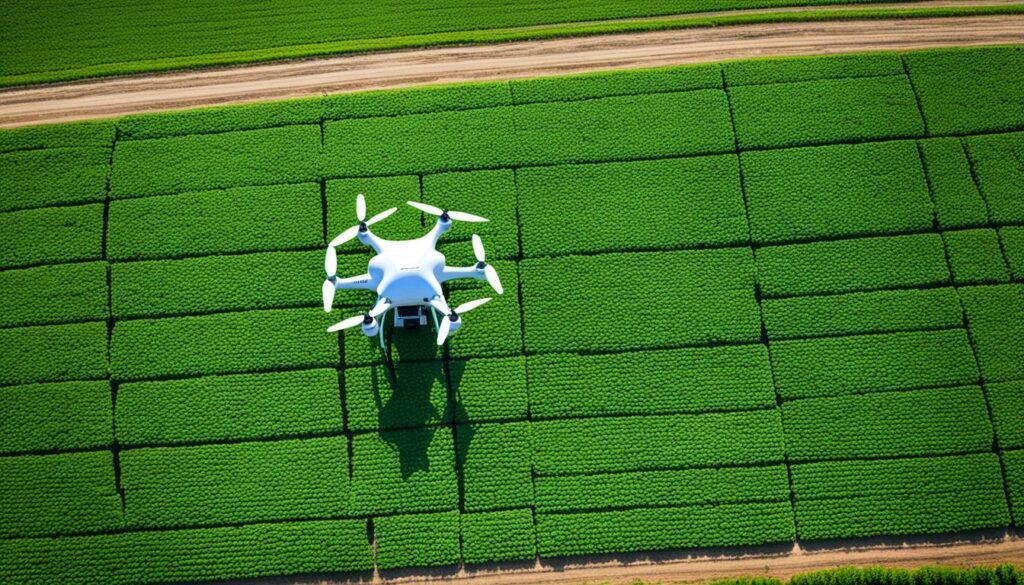
New tech is changing precision agriculture fast. The use of agricultural IoT applications is making farming smarter, with tools for real-time checks and better crop management. Thanks to satellites, we now have very detailed data for smart farming choices. AI is also being used to boost the quality of harvests and make farms more efficient in using water and energy.
Startup Activity: India, Western Europe, and the USA are leading in using AI in farming, as seen in the Global Startup Heat Map.
Integrating different tech tools is helping the market growth in precision agriculture. Technologies like VRT are helping farmers use their resources better, pushing the market forward. It’s expected that by 2028, the market will be worth $16.35 billion, growing at a steady pace of 13.1% each year.
This growth is supported by the rise of farm robots, smart IoT solutions for the environment, and better AI for data. Startups, with help from governments focusing on green farming, are also making a big difference.
Here, you can see how the top tech trends and where startups are most active match up according to the 2022 Precision Agriculture Innovation Map:
| Technology Trend | Examples | Regions |
|---|---|---|
| IOT Applications | Soil Moisture Sensors, Weather Stations | USA, India, Western Europe |
| AI Integration | Crop Planning, Disease Diagnostics | USA, India, Western Europe |
| Satellite Technology | Real-Time Data Collection | USA, Western Europe |
| Variable Rate Technology (VRT) | Resource Efficiency Tools | Western Europe, USA |
In conclusion, new technologies and the work of startups are boosting precision agriculture. This progress means smarter use of resources and more green farming. The market growth in precision agriculture reflects agriculture’s move towards innovation and sustainability.
Precision agriculture is changing how we farm for the better. It uses high-tech tools to boost crop growth and protect the environment. But, there are also some hurdles we need to jump over.
This new way of farming brings many environmental pluses. It helps farmers use their resources wisely, cutting back on waste and harmful chemicals. This clever farming method is good for the earth.
USDA says tech like variable rate and remote sensing can lock up carbon and make farms healthier. It lets farmers plant just enough, which keeps water and soil clean. This is a win for the planet.
Despite the good it does, precision agriculture faces money issues in farming. The high price of the special tech needed is a big barrier, especially for those with smaller farms.
Also, who owns and manages the data from these tools is a problem. Privacy and hacking worries make farmers think twice about using these tools fully. Plus, without clear guidelines, it’s hard to know what to do.
| Aspect | Challenges |
|---|---|
| Up-front Costs | High initial investment in technology and training |
| Data Management | Complexities in data integration and privacy issues |
| Standards | Lack of standardisation in technology use |
We need smart rules and support to tackle these money troubles in farming. Encouraging farmers to use these tools more means showing them the real benefits. By overcoming these issues, we can all enjoy the full perks of precision agriculture. This is the path to a farm future that’s good for everyone.
Digital agriculture is changing farming for the better. It includes software and tools to process farm data. This helps farmers get useful insights, making their work more efficient.
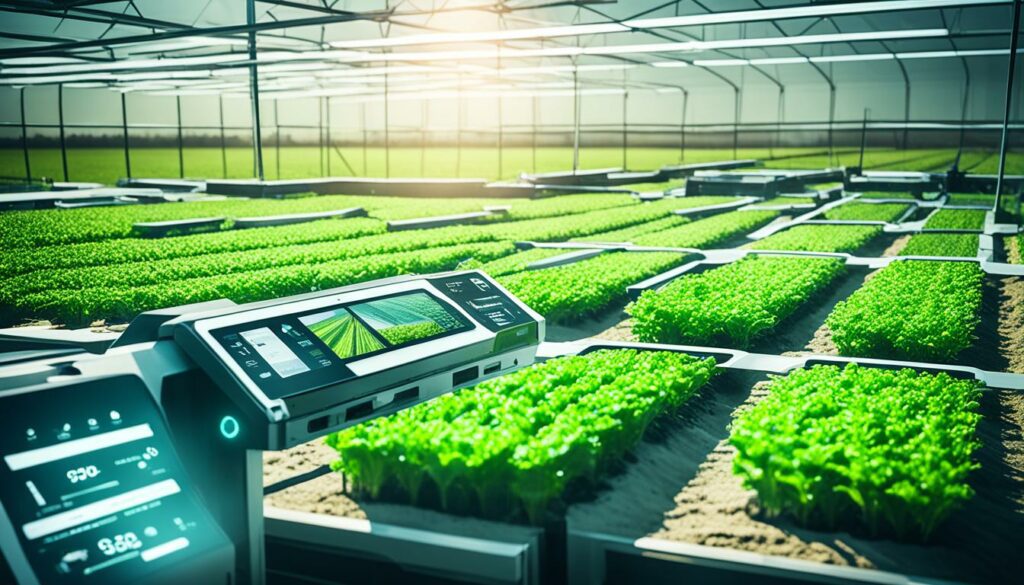
Digital tools and data analysis are central to modern farming. They let farmers keep an eye on farm conditions. By using these tools, farmers can grow crops better and run their farms more smoothly.
USAID and partners are boosting farming through digital solutions. Projects like Digital for Resilience and Food Security bring new technologies into farming. This shows how important digital tools are for agriculture.
Having the right systems to manage data is crucial. They mix different data types for farming use. With these systems, farmers can grow crops in the best way, and operate their farms more effectively.
Publications by the Bill & Melinda Gates Foundation talk about the importance of good data systems. These publications set standards for using data well in agriculture.
There are also campaigns focused on technology aiding farming. They group digital tools into areas like precision farming and financial services. This shows the different ways technology is making farming better. Farmers can use these tech tools to run smarter farms, leading to better results and less harm to the environment.
Advanced tech in precision farming is breaking new ground. These developments aim to make farming more efficient and productive. By embracing these changes, farming can help meet the increasing demand for food without harming the planet.
The use of drones is transforming farming. Farmers can see their crops’ health from above in real-time. This lets them take action quickly, leading to better crop yields. It also means less time spent checking every crop by hand.
Thanks to drones, gathering crop data is easier than ever. Sensors on drones and satellites collect info on crop health and field conditions. This data helps farmers use resources more wisely, reducing waste and boosting productivity.
Autonomous machinery is the latest in farming innovation. These self-operating machines cut down on labour costs and work around the clock. They can plant, weed, and harvest with precision, improving the farm’s output.
Take self-driving tractors, for example. They can map fields with spot-on accuracy. This helps in applying resources efficiently. Automated tools for spraying and planting also play a key role in sustainable farming.
The combination of drones, remote sensing, and autonomous machinery is changing farming. Despite limited use in the U.S., these technologies show a lot of promise. With support from groups like the USDA and NSF, their use is expected to grow. The precision farming market could hit $16.35 billion by 2028. This growth shows how important these technologies are for the future of farming.
The use of IoT in farming greatly boosts how well farms work. The world’s connected farming market is set to reach a huge USD 12.6 billion by 2027. This is very important because it helps us feed more people and meet the growing demand for food. Let’s look at the key parts of these IoT farming tools that are making farming smarter.
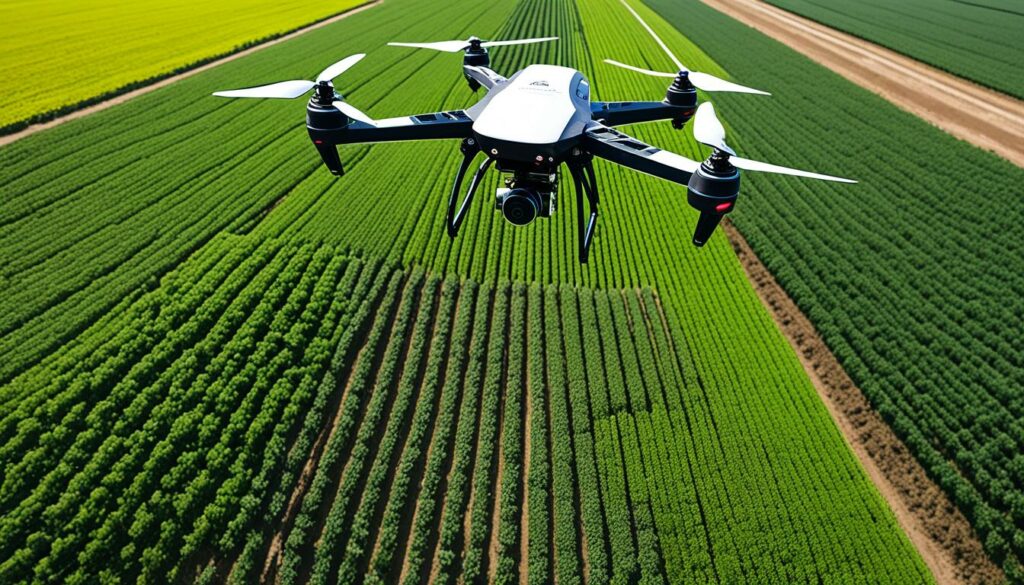
IoT sensors are at the heart of making farming smarter. They keep an eye on things like the moisture in the soil and the weather. With them, farmers can make decisions faster and more accurately. The use of IoT devices on farms is growing quickly, with a 20% annual increase. We went from 13 million devices in 2014 to an expected 225 million by 2024. This helps farmers monitor weather and farm more precisely, which leads to better harvests and lower costs.
Connecting farming operations helps data flow smoothly. These smart connections are key for using resources better and improving how productive farming is. The global market for connected farms was worth USD 1.8 billion in 2018. However, it’s expected to grow to USD 4.3 billion by 2023. This growth is driven by more farms using IoT. Smart connections give farmers better data, which helps them make smarter choices. This is great for things like managing climate in greenhouses and looking after livestock.
| Year | Market Value (USD Billion) |
|---|---|
| 2018 | 1.8 |
| 2023 | 4.3 |
| 2027 | 12.6 |
Farming with IoT is growing fast and changing how farms work. These technologies make farming more efficient and productive. They also help make farming better for the planet by cutting waste and using resources smarter.
Modern farming leans heavily on precision agriculture. This approach uses advanced tech to make farming more accurate and efficient. It’s all about embracing new farm automation and improving practices with the Internet of Things (IoT).
Some key new ideas in farming include autonomous machines and using big data to plan better. Autonomous tractors and drones are now common, planting and checking crops with incredible accuracy. Farming is also becoming smarter with tools that keep an eye on animal health and measure how well they’re doing.
This is done using sensors and analysing data. With big data, farmers can predict risks and make smart choices based on soil and animal health. It turns big, complex data into useful steps.
Smart farming has a bright future, although not everyone’s using it yet, especially in places like Italy. Efforts to share farming knowledge and promote innovation are growing in these places.
The use of IoT, remote sensors, and positioning systems will make precise farming more popular around the world. It’s not just about the tech; support from groups like the USDA will also help. They provide funds and advice to overcome big costs and encourage more innovation.
| Factors | Benefits |
|---|---|
| Precision farming technologies | Sustainable soil management, enhanced product quality, reduced chemical use |
| Big data analytics | Predictive analysis, optimal resource utilisation, increased profitability |
| IoT and autonomous machinery | Increased efficiency, reduced labour costs, better crop and livestock monitoring |
| Policy support and financial assistance | Overcoming high up-front costs, encouraging technology adoption |
Today’s cutting-edge farm tech and the future of smart farming are changing agriculture. These developments help farming keep up with our growing need for food, all while being careful with the environment. Using the latest farming innovations, the farming industry can work more efficiently, produce more, and look after the land better.
The future of farming is driven by sustainable agri-tech. These innovations help meet growing food demand, expected to rise by 70% by 2050. They focus on using resources better, especially water and soil, for farming that’s efficient and kind to the planet.
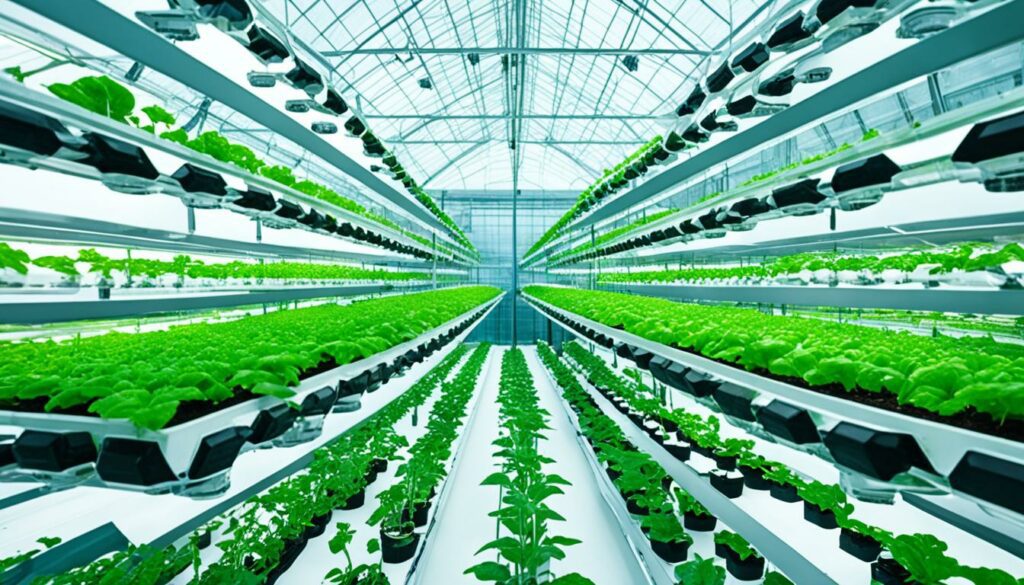
A key tech for saving water in farming is precision irrigation. It uses real-time data to water crops just right, avoiding waste. It’s part of a growing market expected to be worth $16.35 billion by 2028.
Indoor vertical farming is another standout, using up to 70% less water. This method controls the environment, making sure every water drop counts. It also cuts down on the use of natural water and reduces costs. These new ways are vital for saving water in farming.
Tech for managing soil health is also crucial. Real-Time Kinematic (RTK) mapping, for instance, offers precise field measurements. This tech reduces chemical use, targets nutrients better, and improves soil as time goes on.
Minichromosome tech is essential too, making crops tougher against pests and drought. It boosts yield while keeping the soil’s health in check, lessening risky chemical use. Combined with smart data use, it allows for exact fertilising, ensuring the soil stays healthy over time.
| Innovations | Benefits |
|---|---|
| Precision Irrigation Systems | Optimises water usage, reduces wastage |
| Indoor Vertical Farming | Uses 70% less water, cuts labour costs |
| RTK Mapping | Enhances soil productivity, reduces chemical use |
| Minichromosome Technology | Makes crops pest-resistant, conserves soil health |
These agri-tech advances mark a big move towards farming that’s both efficient and eco-friendly.
The use of robotics in agriculture is making big changes to farming. By 2050, our world will have 9.7 billion people. To feed them, we’ll need to produce 70% more food. This shows why it’s so important to use new tech to farm better and make more food.
Many farms lack enough workers. Farming is expensive, and most of the cost is in paying workers. Because of this, around 31% of farmers are growing crops that need less work. But with robots, farming can be done faster and with less need for people. For example, American Robotics’ machines can do the work of 30 people in a few days. This saves money and time.
Now, autonomous tractors and harvesting robots are becoming key in farming. They’re part of modern farming that aims to use technology to grow more food without harming the environment. These new tools mean farms are more productive, use less chemicals, and save money. This all helps farms to be more eco-friendly.
But, using these new farming tools isn’t easy. They cost a lot to start with and can be hard to use. This is especially true for farmers in poorer countries. Also, keeping these high-tech machines working can be expensive. This makes it hard for everyone to use them widely.
Even with these challenges, it’s clear that farming with robots is the way forward. By doing this, we can feed more people around the world. For more information on how technology is changing farming, visit the Plug and Play Tech Center.
Remote sensing in agriculture has changed how we look at and manage farms. It combines imaging technologies with satellites to check on crops, soil, and weather. With detailed images and data, farmers can use precise methods to save resources and boost their harvests.
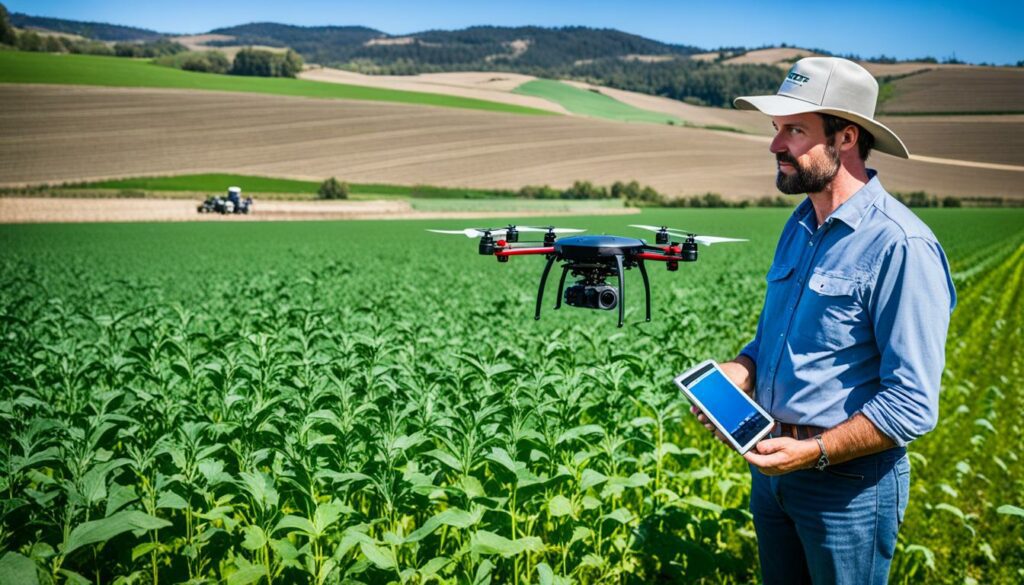
Imaging tech is key in improving farming practices. Things like infrared spectroscopy and spectral imaging are used to check seed quality and spot plant diseases. These tools give farmers up-to-the-minute information and help them plan better farming strategies.
Satellites give us a big-picture view of farms and the land they’re on. They’ve been aiding farmers since the 1970s, making it easier to manage soil, water, and protect crops. They’re also vital in warning about and preparing for disasters like droughts or floods.
Below is a table that compares different remote sensing platforms and what they’re used for:
| Platform | Resolution | Applications |
|---|---|---|
| Satellites | Medium (5–10 m) | Soil management, irrigation control, disaster risk mitigation |
| UAVs (Drones) | High (1–3 m) | Crop health monitoring, nutrient management, farm surveillance |
| Aircraft | Variable | Large-scale surveying, multispectral imaging |
Remote sensing with satellites is key for today’s farming. It helps farmers grow more food with less impact on the environment. This way, we can make sure our farms work well without hurting the planet.
Data-driven farming is changing how we grow food today. Because of high-tech analysis, farmers can use their data to make better choices. These decisions help save resources and make their farms more productive. So, advanced analysis turns loads of farming data into smart ways to manage a farm.
A study by the FAO found that global crop yields jumped a lot in the 20th century. Now, with data science, we can make crops even better by up to 20%. This also means we use fewer harmful fertilisers, saving water too. These methods offer a greener way to feed the future, aiming to produce 70% more food by 2050.
One cool thing is that predicting crop yields with computers is over 90% accurate. This helps farmers spend their resources wisely. It cuts down on pollution, as a World Bank report shows. And, it means we use fewer pesticides, keeping the land and its creatures safe.
Farms can differ a lot, which affects how well crops grow. But, computer models can figure out the best ways to use water on each part of the farm. This makes farming smarter, using the right amount of water, at the right time, in the right place.
Looking closely at soil and plants is also very important, even if it costs more. Doing thorough checks can really help manage the farm better. Devices that watch crop yields closely without much cost can help pinpoint what’s making yields up and down. Things like stress or bugs can change how well crops grow. Knowing these details can help farmers do much better.
| Aspect | Impact |
|---|---|
| Yield Increase | Up to 20% |
| Fertiliser Usage Reduction | 15% |
| Water Usage Reduction | 25% |
| Accuracy of Yield Prediction | Over 90% |
| Greenhouse Gas Emissions | Significant reduction |
Urban areas are growing fast. This makes new farming methods like indoor vertical farming very popular. These new ways of farming are better for the environment and help make sure we have enough food.
Indoor vertical farming has brought cool new ways to grow crops. Hydroponics allows plants to grow without soil. They get their nutrients from water. This saves land and uses less water than farming with soil.
Aeroponics is even cooler. It grows plants in the air by misting them with nutrient water. This uses the least water of all. Both methods help grow food all year in special indoor conditions.
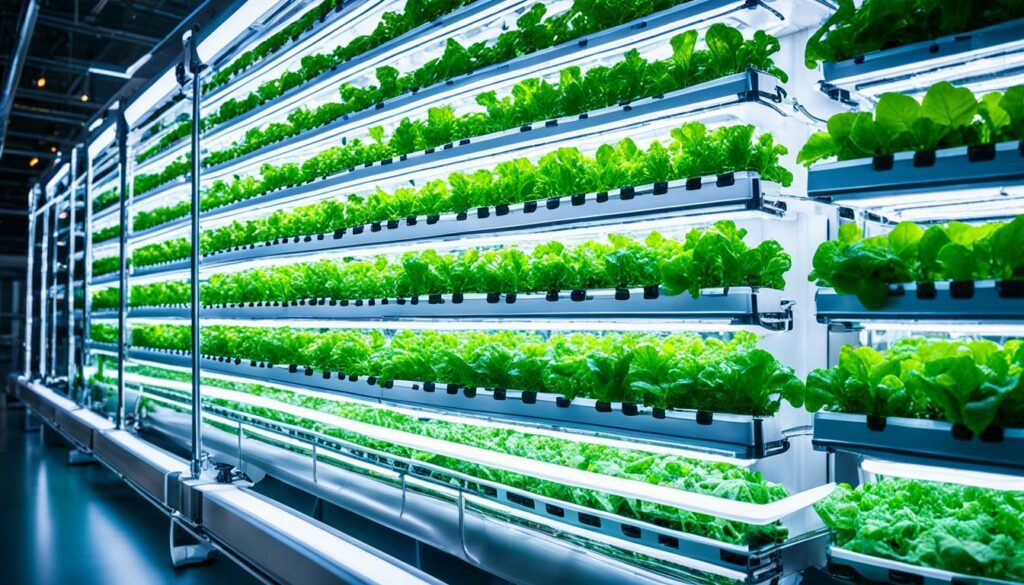
Indoor farming’s success often depends on fancy control systems. These systems watch the temperature, humidity, and light for the crops. They adjust these conditions to make the plants grow best.
But that’s not all. Indoor farms also recycle water. This saves water and makes farming more efficient. Adding special LED lights helps plants grow better too. All this makes farming indoors a smart and green choice for the future.
Bee vectoring technologies are a major step in eco-friendly farming. They use bees in a new way to protect crops naturally. This means farmers don’t need to use harmful pesticides. It boosts harvests and helps the planet too.
This tech is great for the environment. It uses less water, fewer machines, and no fake pesticides. For example, a farm in Georgia saw a 28% bigger harvest with this method. Also, farms can make back 20 times the money they spend, making it a smart choice for farmers.
Having bees help spread good things like C. rosea is key. It makes pollination better and plants stronger, leading to healthier fruit. Plus, safety tests show this doesn’t harm bees, their young, or the honey. It’s been so successful that in a field of strawberries, a 35% drop in a disease was seen.
In all, bee vectoring is shaping the way farming is done. It brings real advantages for both crops and our planet. With the farming tech market set to grow big, these bee methods are vital for a greener and more profitable future in farming.
As food demand rises and water becomes scarce, managing water in agriculture is critical. By 2050, the world’s population is estimated to grow by 70%. Therefore, using systems like precision irrigation and recycling water is key for farming’s future.
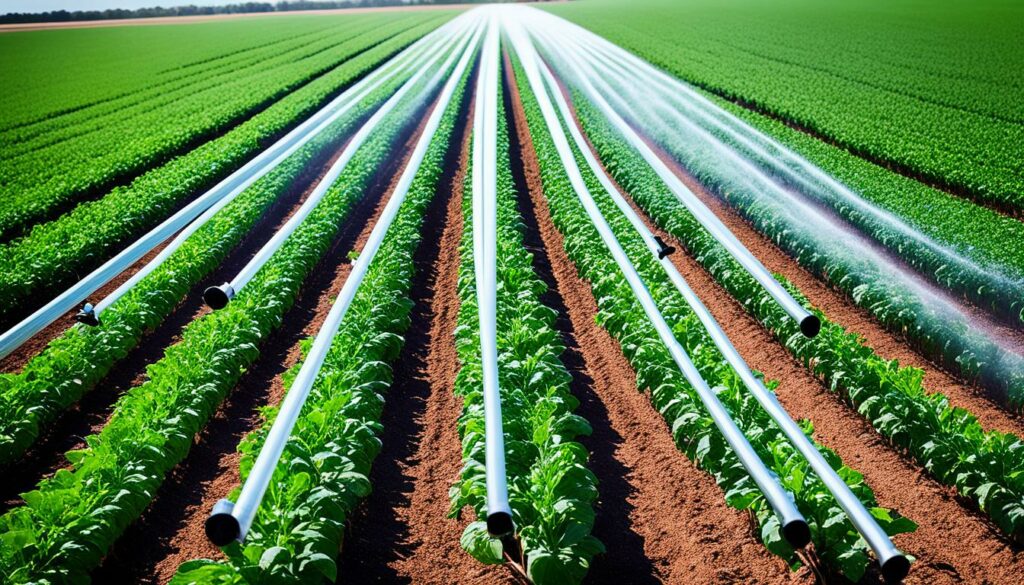
Precision irrigation systems save water and help crops grow better. They direct water where needed with drip and sprinkler systems. This can cut down on water waste. Smart irrigation, as stated by Agritech Tomorrow, helps farmers save water and grow more crops.
Reusing water in farming is highly beneficial. It cuts down on water use and makes farming more efficient. For example, WaterWise technology in Australia showed a 35% water cut in growing tomatoes. As a result, WaterWise aims to boost Australia’s farming by $1 billion in 2030, with $43 return for every $1 spent.
Using these technologies doesn’t just save water. It also helps feed those in our world still lacking food. As the precision farming market is set to grow to $16.35 billion by 2028, these techniques will be vital for farming’s future. They support sustainable and high-yield farm practices.
Farm management software helps farmers in big ways today. It keeps track of real-time data and makes farming tasks easier. You can make better decisions, use resources smarter, and plan everything better all in one place.
For instance, Taranis offers top-notch help for crops. It lets advisors show farms their value by checking more acres quickly and finding problems fast. This means farmers get advice when they need it, making decision-making faster and better.
Taranis also helps seed new chances for farmers, aiming to boost harvests and make more money. It digs deep into crop problems like weed amounts, diseases, pests, and more. With detailed drone photos, Taranis gives close-up views of plant leaves, vital for managing crops well.
It has the biggest set of crop images thanks to AI learning from lots of data. This makes advice precise and helps with smart choices on the farm. Taranis is there all year, offering full support with the latest tech and farming knowledge.
At events like the 2024 World Ag Expo, FarmX wowed with its tech. They focus on better sensors for up-to-the-minute data. Their work helps farms be greener, grow more, and use tech smartly with tech like Perceptive Navigation® for better farm machines.
To sum up, using farm software is key to running a successful digital farm. They bring together data, tips, and ways to use resources better. This leads to farms that are both profitable and good for the planet.
Precision agriculture has come a long way since the 1990s. It started with simple devices for checking soil. Now, we use high-tech tools like drones, AI, and IoT. These technologies help farmers work smarter.
Thanks to satellite images and sensors, farmers get instant updates on their crops. They can see how healthy their plants are and if they need more water. This helps farmers look after their crops better.
Using automated machines and robots has cut down on mistakes. It’s made farming more efficient. Now, farmers can predict what their crops might need. This means they can take action early to get better harvests.
The future of farming depends on teamwork. Tech companies, scientists, and farmers need to work together. By joining forces, they can improve how we grow food. This helps keep our food supply safe and the environment healthy.
Precision agriculture, known also as precision farming, uses tech to spot and act on differences within fields. It aims to make farming more productive and better for the environment.
It came about with the rise of sensors, GPS, and quick data analysis. This tech turned traditional farming into a more precise and efficient process for growing crops.
Important trends are in IoT, machine independence, and very accurate location solutions. These are thanks to new businesses, government help, and a growing demand for eco-friendly farming methods.
This type of farming helps the environment by making use of data for better decisions. It cuts down on waste, lowers chemical use, and helps capture CO2, making farming more eco-friendly.
The big costs to start and for learning about the tech can be a challenge for farmers. They might also face problems with how to handle data and the tech working together.
Digital tools help manage big chunks of data, mix different types of data, and give clear advice. This helps in making better decisions, growing better crops, and making farms run smoother.
Drones give live images of crops to check on their health. Remote sensing allows for spot-on use of resources, changing the way farms are watched and managed.
IOT sensors keep an eye on important things like soil dampness and weather. They help in making farming choices better. Good connections for the data are key for modern farming techniques.
Recent innovations link to more independent tech and better IOT features for farming. These advances promise to raise crop amounts and make farming more sustainable.
New tech like focused watering and calculated fertilisers help save water and keep the soil healthy. This makes farming more efficient without using up too many resources.
Automated farms and robots, including clever tractors, make farming more able and focused. They lower the demand for workers and up crop amounts by providing accurate support.
Remote sensing, with images and satellites, checks on crop health, soil, and the weather. This leads to better farming practices and getting the most out of crops.
Data-driven farming uses high-level maths to turn lots of farming data into smart strategies. This improves the soil, helps crops, and uses resources better in farming.
Techniques like hydroponics allow growing crops indoors, without soil, using important nutrients. This saves space and resources, and farming can be done all year.
Bee vectoring uses bees for natural protection, which cuts down on chemicals. It also helps crops grow more, making farming better for the long term.
New irrigation and water reuse methods help use water better, making farming more sustainable.
Special software helps farmers manage activities and data in real time. It makes farming smarter by organising tasks, supply chains, and money better.